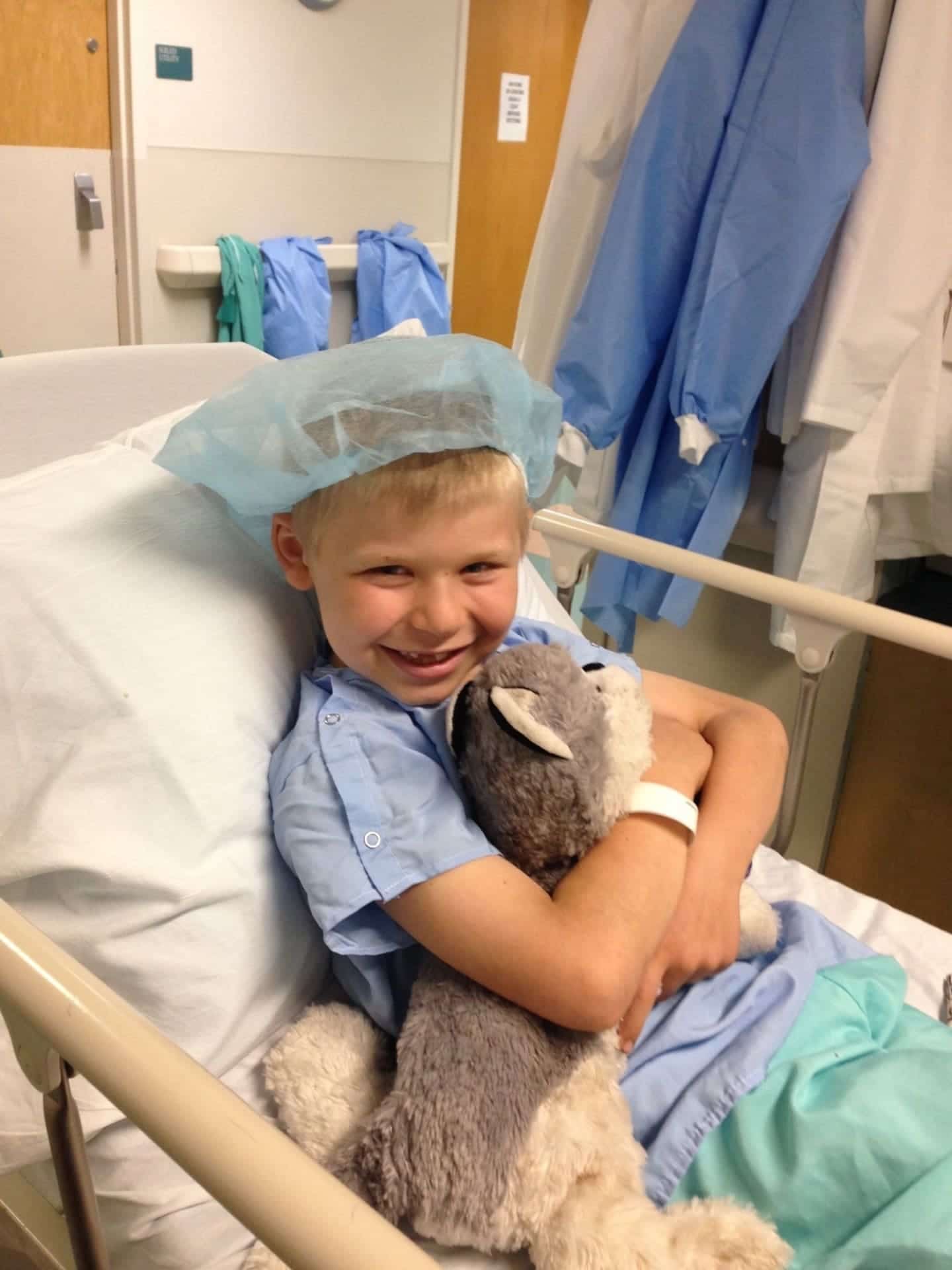9 tips + tricks to prepare for your child’s surgery

Your emotions may be everywhere at once, but you've got this, mama.
Table of Contents
- If any of your doctor's recommendations seem vague or unclear, don't hesitate to ask more questions. Ultimately, remember that the goal of parent education is never to create more worries, but rather to remove some of the stress of uncertainty.
- 1. Follow eating and drinking recommendations carefully.
- 2. Your scheduled surgery may happen sooner or later than expected.
- 3. Intraoperative time also varies widely—so don’t panic.
- 4. You may be asked to stay in the recovery room to reorient your child post-op.
- 5. They may be able to bring their favorite stuffed animal or a blanket into the operating room.
- 6. You may even be allowed to enter the OR to see your child off to sleep.
- 7. Older children may be offered the option of going to sleep with a mask OR an IV.
- 8. You’ll likely be asked the same questions repeatedly.
- 9. Understand they may not act their age.
So you’ve been told your child needs surgery. Your emotions may be everywhere at once. You may have gotten a second opinion, or even a third, before consenting to proceed with surgery, coming close to choosing your baby’s surgeon with higher standards than your life partner.
Understandable.
As the operation date approaches, questions race through your mind at frequent and spontaneous moments, and few things can help keep you sane, focused, and relaxed. If possible, take time to do a fun activity with your child, read a favorite story, or watch that episode of Troll Hunters together that you’ve seen too many times to count.
As an anesthesiologist and mom, here are some recommendations from inside the operating room to educate yourself about what to expect if your child is having surgery. While these guidelines are not absolute, they’re meant to help navigate the medical system used by your child’s caregivers and to be aware of what they’ll ask of you.
If any of your doctor’s recommendations seem vague or unclear, don’t hesitate to ask more questions. Ultimately, remember that the goal of parent education is never to create more worries, but rather to remove some of the stress of uncertainty.
1. Follow eating and drinking recommendations carefully.
You may think it will only be a minor inconvenience if your child feels nauseous after surgery, and consider giving her food before the procedure because they need to eat. But, even if your toddler is having tantrums of epic proportions, resist the urge to feed her as it can really make her sick afterward. Rest assured that she’ll be kept hydrated during surgery.
Fasting guidelines are extremely important and have been developed by the American Society of Anesthesiologists for your child’s safety. Having an empty stomach is critical to preventing the aspiration of stomach contents into the lungs. In serious cases, this occurs when stomach acid refluxes upward and can cause fatal pneumonia.
It’s usually okay to have breast milk or clear fluids, such as apple juice, no sooner than two hours prior to surgery. Solid foods, formula and cow milk take much longer to empty from the stomach and should not be given before. Always check with your doctor’s office for individual recommendations.
2. Your scheduled surgery may happen sooner or later than expected.
While it can be frustrating when plans change, try to remain patient with the doctors, nurses and staff. If your baby’s case is delayed, it means the staff is busy preparing the operating room properly or giving another child the same meticulous attention that will be given to your child when it’s their turn.
It’s a good idea to bring some toys or activities to pass the time for both yourself and your child . A phone and charger in case the doctor needs to reach you for an update is a good idea, too. Books, magazines, stickers and crayons are all useful. It’s also wise to make childcare arrangements for your other children in the case you’re at the hospital longer than expected.
3. Intraoperative time also varies widely—so don’t panic.
Your child’s surgery may take longer than expected. Some surgeons take twice as long as others to do the same operation. But, it doesn’t mean anything is wrong! If surgery goes on much longer than what was discussed with you, it’s reasonable to ask the operating room staff to call into the room for an update. As soon as surgery is complete, your surgeon will give you a report of how the operation went.
4. You may be asked to stay in the recovery room to reorient your child post-op.
Every facility has a different policy, and some centers may have you rejoin your child when they are more awake. Emergence reactions, such as kicking or eyes moving around in different directions, are common following surgery, and these are usually normal. They may even say odd things, stare blankly, or cry. As the anesthesia wears off, these reactions will dissipate.
5. They may be able to bring their favorite stuffed animal or a blanket into the operating room.
Make sure it’s a subtle and small toy. While infection control rules are different everywhere, most doctors will allow small items that help decrease separation anxiety and help to comfort children.
6. You may even be allowed to enter the OR to see your child off to sleep.
Ask ahead of time to put on the proper attire required to enter the operating room, such as scrubs or a mask, surgical cap and paper suit that cover your clothing and hair. After your child goes to sleep, you’ll be escorted back to the waiting room.
If you’re squeamish about medical settings, this probably isn’t a good choice for you. The doctors and nurses will have two patients to care for if you suddenly feel faint. If you choose to let your child go in alone, trust that they will be well cared for by medical professionals. If you’re still struggling with this leap of faith, patient advocates and spiritual care are often available to visit with you during this time to help with anxiety.
7. Older children may be offered the option of going to sleep with a mask OR an IV.
If your child is squeamish about needles, they can breathe a sleeping gas through a mask similar to an aviation-style pilot’s mask as an alternative to IV placement. The mask typically smells like a plastic toy. Pediatric anesthesiologists may offer your child a choice of scented lip balm flavors that they can choose to put on the mask, too.
The sleeping gas is usually described as smelling like apples and it only takes a few breaths to induce general anesthesia. If your child is claustrophobic or doesn’t like the idea of a face mask, an intravenous induction with an injectable medication also works quickly and is appropriate for many children. Talk with your surgeon to see if your child can have the option to feel most comfortable.
8. You’ll likely be asked the same questions repeatedly.
This redundancy is meant to prevent medical errors. It may be frustrating when the third staff member asks you if your child has any allergies and what surgery your child is there to have performed. It may even seem like they don’t know what the plan is, but this repetition is built into the system of checks and rechecks to increase patient safety and to make sure that a patient going into surgery to have their broken elbow repaired does not wake up a tonsillectomy. As you can imagine, with children, extra precautions are taken to verify that the correct surgical site, correct side, and corrective surgery are performed, since children are often too young to speak for themselves.
9. Understand they may not act their age.
Your child may revert to more childish stages of behavior in the time before and after surgery. This is completely normal. Tantrums in older children, bed wetting or crying may be signs of anxiety when children cannot express their fears verbally.
This reversion to earlier stages may be more common in children with chronic medical conditions who have had a repeated procedure, but not always. This should pass, as the anesthetic and pain medications wear off completely. Providing a supportive environment and reassurance is valuable to your son or daughter during this time.
When you meet your anesthesiologist and surgeon, keep in mind that even doctor moms and dads feel a sense of powerlessness when seeing their child wheeled off to surgery. “Even though I knew intellectually it was minor surgery (ear tubes), I felt I was giving up my little girl to a woman I had just met,” says Dr. Tricia Wright.
You’re not alone, and neither is your child when they leave your arms. They’ll be surrounded by doctors and nurses who may even be parents, too, and are sharply focused on the safety and comfort during their time under anesthesia and the postoperative recovery phase.
Most importantly, trust yourself as a mom to make personal decisions in your child’s best interest, and to care for them, equipped with the knowledge of what to expect surrounding their operation.
Mama, you’ve got this.





































